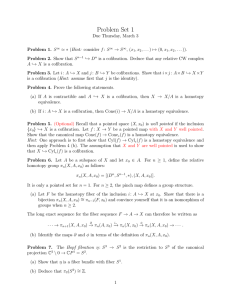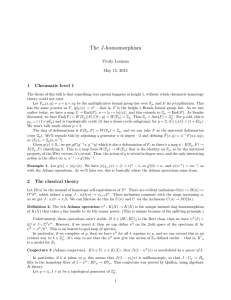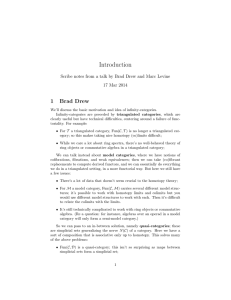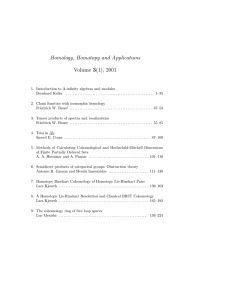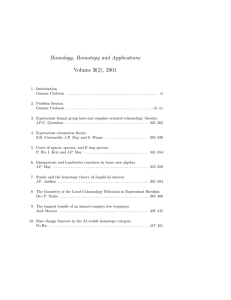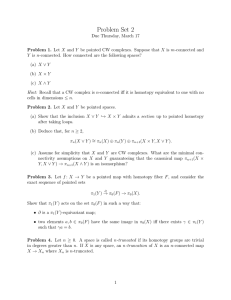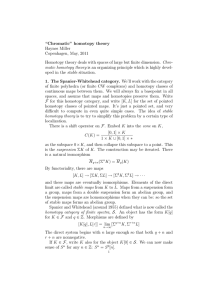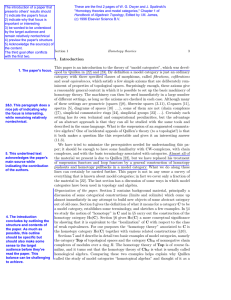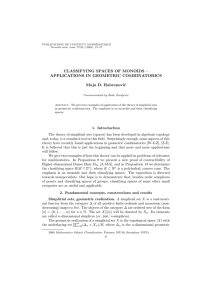Morel’s A -connectivity theorem and homotopy t-structures 1
advertisement
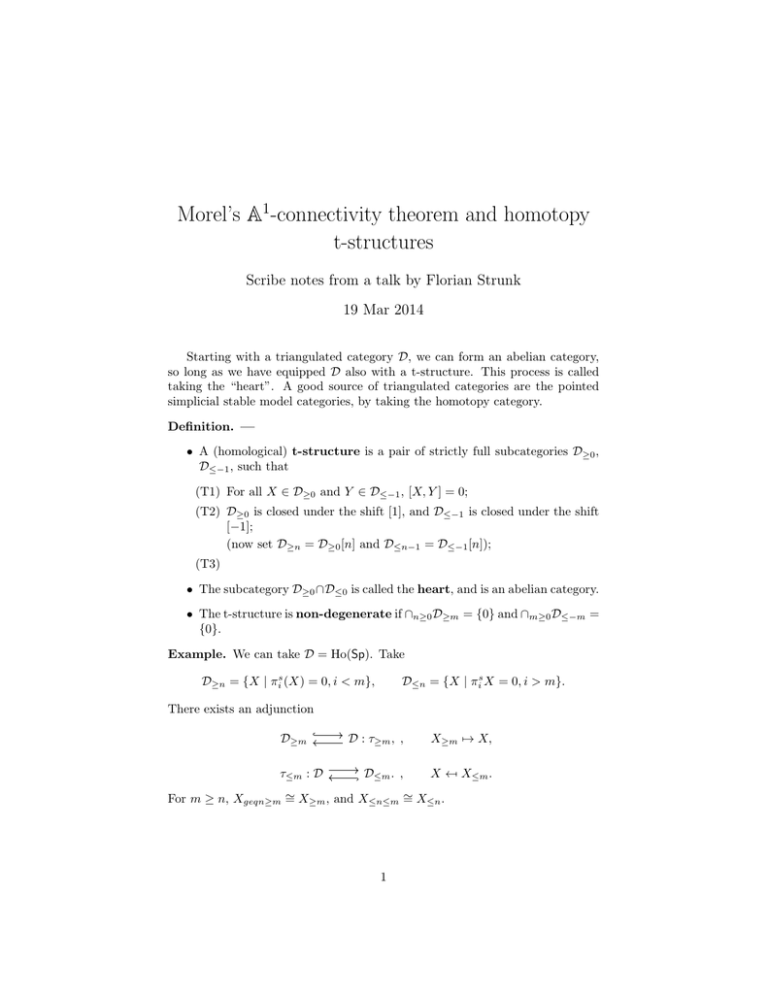
Morel’s A1-connectivity theorem and homotopy
t-structures
Scribe notes from a talk by Florian Strunk
19 Mar 2014
Starting with a triangulated category D, we can form an abelian category,
so long as we have equipped D also with a t-structure. This process is called
taking the “heart”. A good source of triangulated categories are the pointed
simplicial stable model categories, by taking the homotopy category.
Definition. —
• A (homological) t-structure is a pair of strictly full subcategories D≥0 ,
D≤−1 , such that
(T1) For all X ∈ D≥0 and Y ∈ D≤−1 , [X, Y ] = 0;
(T2) D≥0 is closed under the shift [1], and D≤−1 is closed under the shift
[−1];
(now set D≥n = D≥0 [n] and D≤n−1 = D≤−1 [n]);
(T3)
• The subcategory D≥0 ∩D≤0 is called the heart, and is an abelian category.
• The t-structure is non-degenerate if ∩n≥0 D≥m = {0} and ∩m≥0 D≤−m =
{0}.
Example. We can take D = Ho(Sp). Take
D≥n = {X | πis (X) = 0, i < m},
D≤n = {X | πis X = 0, i > m}.
There exists an adjunction
D≥m
τ≤m : D
D : τ≥m , ,
X≥m 7→ X,
D≤m . ,
X ←[ X≤m .
For m ≥ n, Xgeqn≥m ∼
= X≥m , and X≤n≤m ∼
= X≤n .
1
Let D = Ho C. Then
holimn→∞ X≥n
...
X≥n+1
X≥n
...
hocolim X≥n
X
...
X
X
...
X
...
X≤n
X≤n−1
...
hocolim X≤n
∼
holimn→∞ X≤n
The equivalence in the lower left expresses that Postnikov towers converge, the
following lemma:
Lemma. If the t-structure is non-degenerate and the sequential
homotopy limit
Q
of objects in D≥0 is in D≥−1 (e.g. D≥0 is stable under ), then
∼
τ≤m X −
→ τ≤n holim X≤m .
How to get a t-structure
Let C be an (I, J)-cofibrantly generated, pointed, simplicial, stable, and finitely
generated model category. According to Hovey,
∪n≥0 cofib(I)[n]
detects weak equivalences, and each object of it is small ([−,
`
`
Ai ] ∼
= [−, Ai ]).
Lemma. Let J consist of small objects. Then taking
D≤−1 = {Y ∈ D | [S[n], Y ] = 0 for all n ≥ 0, S ∈ J},
J = D≥0 = {X ∈ D | [X, Y ] = 0 for all Y ∈ D≤−1 }
is a t-structure.
Proof. (T3) Consider
X → Y → Z,
with X ∈ D≥0 and Z ∈ D≤−1 .
a
d
1
S[n] → Y −→
Φ1 Y
n≥0
S∈J
[S[n],Y ]
2
Inducting, we produce
F0 = 0
Y
Y
F1
Y
Φ1 Y
..
.
..
.
..
.
hocolim Fk = X
Y
hocolim Φk Y
We now apply this to motivic homotopy. Let SHsS 1 be the stable category
with only the Nisnevich topology localized, not A1 , and with only S 1 inverted.
• On SHsS 1 , we obtain the simplicial t-structure, giving the heart Shv(Sm/k ).
• On SHS 1 , we obtain the S 1 homotopy t-structure, giving the heart
Shvst (Sm/k ).
• On SH, we obtain the P1 homotopy t-structure, giving as heart the π∗
homotopy modules.
For the first, the weak equivalences are maps that induce isomorphisms on
all homotopy sheaves
πn (E) = colim aNis πn+k (Ek (−)),
k→∞
where aNis is the sheafification. Our suspension is Σ(−) = S 1 ∧ −. We take
J = {Σ∞
S 1 U+ | U ∈ Sm/k }.
Lemma.
D≤−1 = {abelian no-positive-homotopy sheaves},
D≥0 = {abelian no-negative-homotopy sheaves}.
Theorem (Kato, Saito). Let G ∈ Shv, X a noetherian scheme of Krull dimension d. Then
n
0 = HNis
(X; G) = [Σ∞
S 1 X+ , HG[n]],
n > d.
Here HG is the Eilenberg–Mac Lane spectrum. We then have an equivalence
H
Heart
Shv(Sm/k ).
π0
3
1
Pic(X) = HZar
(X; Gm )
1
= HNis
(X; Gm )
= [X+ , HGm [+1]]
= [S −1 ∧ X+ , HGm ]
Let J = {Σ∞
S 1 U+ | U ∈ Sm/k }.
Theorem (Morel’s stable connectivity theorem). If E ∈ D≥0 , then E is A1 connective:
aNis [S n ∧ (−)+ , L∞ E]SHs 1 = 0
S
for n < 0.
Fact. Let E ∈ SpsS 1 and X ∈ Sm/k of Krull dimension d. Then [X+ , E≥n ] = 0
for n > d.
The construction is roughly as follows. We have the evaluation map
hom• (A1 , E)
ev1
•
E
cof
R(−)
L1 E
and the upper-left is A1 -contractible.
So
D≥0 = {E | φn,m E = 0, n < 0, ∀m},
D≤−1 = {. . .},
where we follow the convention
, Ek ]A1 .
πn,m = colim aNis [S n+k ∧ Gk+m
k
{z m }
|
S n+2k+m,k+m
Definition. A homotopy module (M• , µ• ) is a Z-graded strictly A1 -invariant
sheaf, together with
µm : Mm → (Mm+1 )− 1
= ker(Mm+1 (Gm × −) → Mm+1 (−))
= hom• (Gm , Mm+1 )
By saying that G is strictly A1 -invariant, we mean that
n
n
HNis
(X × A1 , G) ∼
(X; G)
= HNis
for all n.
4


